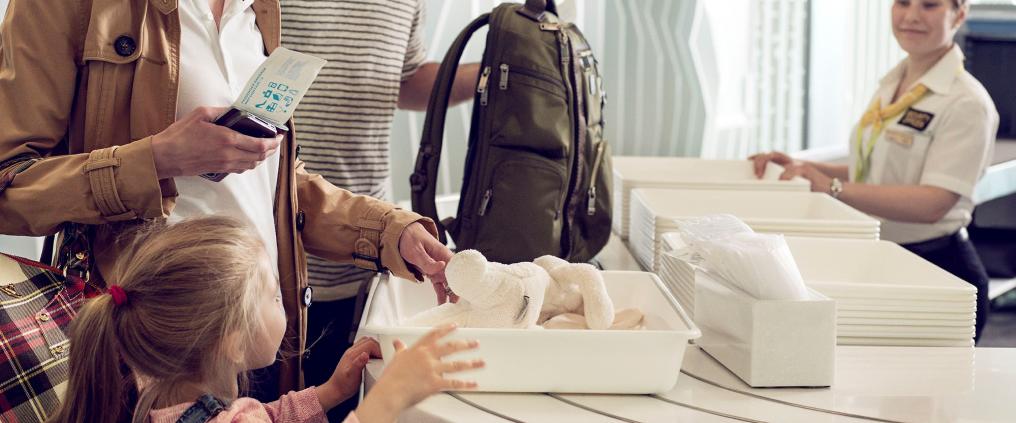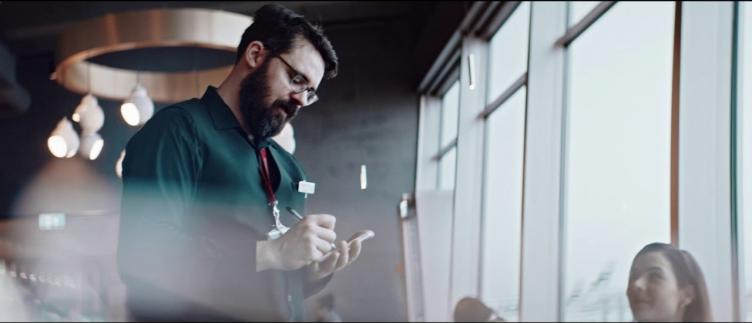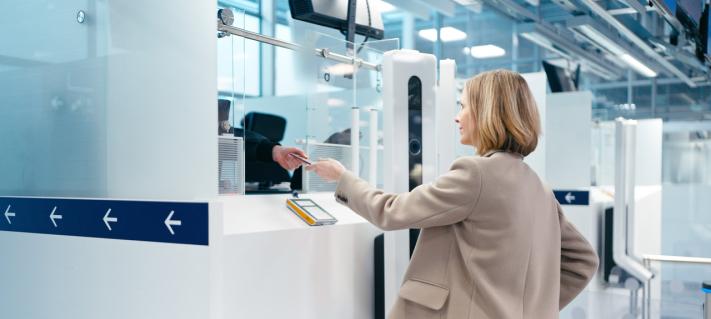The purpose of airport security screenings is to prevent dangerous goods from entering aircraft and to ensure that all flights reach their destinations safely. Therefore, all passengers must walk through a metal detector before entering the gate area, and both hand baggage and checked-in baggage are scanned with an X-ray machine.
But how does an X-ray scanner function? We asked Joni Pekkanen, Security Services Supervisor at Helsinki Airport, and Mikko Halonen, Security Technical Specialist at Finavia’s security technology supplier Oy Machine Tool Co, what kind of technology is behind security screening devices and what good they do.
Scanning technology is based on X-rays
From a passenger’s point of view, an X-ray scanner looks like a boxy tunnel and a conveyor belt, which moves the baggage through the tunnel. Inside the box, the baggage is scanned with X-rays: scanning is enabled by the fact that X-rays penetrate different substances to a different extent.
“The machine produces X-rays with a special tube, which is lined with lead. In the lead lining there is a narrow, around one-centimetre-wide gap through which the X-rays are directed into the tunnel. The conveyor belt carries each piece of baggage through the X-ray beam, and on the opposite side of the tunnel, a detector measures the amount of radiation which has penetrated the scanned item. Dense substances, such as lead, absorb the most radiation, blocking the X-rays’ progression”, explains Mikko Halonen.
“Based on the amount of radiation which has passed the piece of baggage, a computer forms a close to real-time image of the items.”
Orange or blue – different colours for different materials
In the past, X-ray images were black and white. Today, different materials are shown in different colours in the image produced by the computer attached to the scanner.
Organic matter, such as wood, water, plastic and textiles, are coloured orange. Inorganic matter, such as metals, show up as blue.
“If organic and inorganic substances overlap in the scanned item, it appears green on the screen. For example, tennis balls in a metal tube look green. Other substances that are shown in green include salt, glass and bones”, Halonen clarifies.
The denser the substance or the thicker the layer of substance on the X-rays’ way, the darker the item appears on the computer screen. Substances which are too dense for the radiation to run through appear black.
3D images with new technology
According to Joni Pekkanen, the development of technology has made images sharper and the scanning process smoother. Images can be modified to get a better view of the contents of the scanned baggage, he says.
“At Helsinki Airport we use, for example, so-called dual view machines that produce two different images of one scanned item. What this means in practice is that we seldom have to re-scan baggage, which makes screening flow more smoothly,” Pekkanen explains.
New scanners have been ordered for Helsinki Airport’s baggage handling centre. With a combination of X-rays and CT technology, or computer tomography, these scanners will automatically detect explosives.
In CT scanning, the source of radiation rotates around the scanned item at a high speed, and a three-dimensional image can be produced. One new machine can scan up to 1,800 bags per hour.
No harm to people or baggage from radiation
The radiation from security scanners is not harmful to people or baggage.
“A scanned item is exposed to a radiation dose of roughly one micro sievert, which is the equivalent of the dose of cosmic background radiation you’re exposed to during an hour’s flight at ten kilometres’ altitude”, says Pekkanen.
“That’s ten times smaller than the dose from a dental X-ray”, illustrates Halonen.
Baggage on its way to the cargo bin is screened with machines that are slightly more powerful but equally harmless.
“The whole tunnel in the machine is lined with lead, so practically no radiation can escape it. Moreover, X-rays don’t contaminate scanned items”, Halonen explains.
According to Pekkanen, there is effectively no ordinary baggage that could be harmed by X-ray scanning. There is one exception to this rule:
“With highly sensitive photographic or cinematographic film, there is a slim risk of damage. If you’re carrying film with a high ASA number, it’s a good idea to pack it in your hand baggage and to mention about it to security officers before the screening. Ordinary film will not be damaged by the scanner”, he says.
Under what circumstances are bags opened after scanning?
Occasionally, security officers want to take a closer look at your baggage. How do they decide when a scanned bag must be opened for inspection?
“Primarily, the security officer monitoring the scanning is responsible for making the decision about opening a bag, but automation also has a role. If the computer or the officer detects forbidden goods or an unidentifiable substance in the scanner image, the bag will be opened”, says Pekkanen.
“Technology is a developing aid that helps us to identify risks”, Pekkanen sums. In addition, inspections based on random sampling are carried out.
“A certain percentage of baggage must be inspected at random to increase security. Randomised inspections are selected based on automation so not even the security officer will know, whose luggage will be inspected”, Pekkanen says.
Read how Finavia uses artificial intelligence in service design
Safety guides everything we do - Read more about responsibility at Finavia





